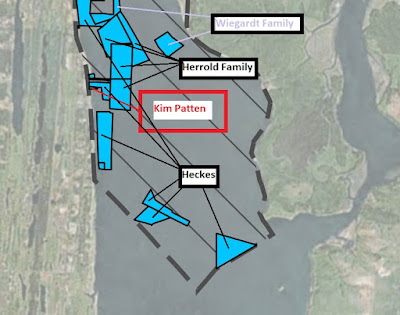These are not terrestrial farms.
These are tidelands
over which public waters ebb and flow.
WGHOGA wants to apply neurotoxin
into those waters.
These are tidelands
over which public waters ebb and flow.
WGHOGA wants to apply neurotoxin
into those waters.
Get out or our way and let us spray pesticides into Willapa Bay's waters and on shellfish beds.
The Willapa Grays Harbor Oyster Growers Association (WGHOGA) has asked the Department of Ecology to move forward on their application to apply the pesticide Imidacloprid, a neonicotnoid, into Willapa Bay again. A public outcry stopped the ill thought proposal in 2015 (see May 3, 2015 Seattle Times article on cancellation of permit here). Should promoters of clean water also be promoting the application of pesticides (Imidacloprid) and herbicides (Imazamox to kill Japanese eelgrass) into Willapa Bay? The growers below see nothing wrong with that dichotomy. (Click here for DOE public notice of moving forward with permit.)
The Willapa Grays Harbor Oyster Growers Association (WGHOGA) has asked the Department of Ecology to move forward on their application to apply the pesticide Imidacloprid, a neonicotnoid, into Willapa Bay again. A public outcry stopped the ill thought proposal in 2015 (see May 3, 2015 Seattle Times article on cancellation of permit here). Should promoters of clean water also be promoting the application of pesticides (Imidacloprid) and herbicides (Imazamox to kill Japanese eelgrass) into Willapa Bay? The growers below see nothing wrong with that dichotomy. (Click here for DOE public notice of moving forward with permit.)
Who is WGHOGA?
The following are either members of WHGOGA or are companies, families or individuals who have Willapa Bay shellfish beds onto which which they will be applying Imidacloprid, directly or in the waters above them.
The following are either members of WHGOGA or are companies, families or individuals who have Willapa Bay shellfish beds onto which which they will be applying Imidacloprid, directly or in the waters above them.
They include:
Goose Point Oyster and Nisbet Oyster - The Nisbet family
Grassy Island Clam Farm and Stackpole Harbor Oyster - The Sheldon family
New Washington Shellfish, Wiegardt Brothers, Wiegardt and Sons, Wiegardt Oysters and Jolly Roger Oysters - The Wiegardt family
Heckes Oyster Company, Heckes Clam Company - The Heckes familyBay Center Mariculture - Dick Wilson
Olson and Son - Phil Olson
Willapa Fish and Oyster - Eric Petit
Herrold Fish and Oyster - John Herrold
Willapa Bay Shellfish - Warrnen Cowell
Long Island Oyster and Station House Oyster - The Kemmer family
Kim Patten - WSU scientist who has supplied a vast amount of information to support this project will be a direct beneficiary through profits from shellfish grown on his tidelands.
*Taylor Shellfish and Coast Seafoods both claim not to be involved, yet still remain members of the WGHOGA.
Parcel ownerships below are based on Pacific County and DOE information. Based on County records it is believed to be accurate. Not all owners are shown.
North Willapa Bay - 100 acres
(click on image to enlarge)
Central Willapa Bay 1 - 335 acres (1+2)
(click on image to enlarge)
Central Willapa Bay 2
(click on image to enlarge)
South Willapa Bay 1 - 50 acres (1 and 2)

(Note: Kim Patten is the WSU extension agent
who has performed numerous studies
which support the use of Imidacloprid
on shellfish beds.)
It's not dirt. These are tidelands supporting native species and threatened Green Sturgeon over which public waters ebb and flow.
These are not terrestrial farms - this is a critical marine habitat over which public waters ebb and flow. It is a habitat which supports native species, including burrowing shrimp, which are a food source for many other species, including the Green Sturgeon, a species considered "threatened" and whose protected habitat includes Willapa Bay. The oyster the growers wish to grow is an invasive species from Japan, the Pacific oyster, called a "weed" by Bill Dewey with Taylor Shellfish (“The Pacific oyster is kind of the weed oyster of the world,” Bill Dewey, crosscut.com, June 6, 2016). This habitat is no less critical than wetland and should be recognized as such.
Make a difference - Don't buy oysters from Willapa Bay or from those who support this proposal or who are members of WGHOGA. There are alternatives.









